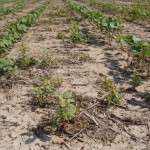In cotton fields many growers are over spraying with Ignite to control the Palmer amaranth. In most cases, they are getting good control on small Palmer amaranth. The injury to Liberty Link cotton from an Ignite application has been non-existent. The injury to WideStrike cotton has been more mixed. When the Ignite was applied before the rain events, cotton injury was very minor. However, after the rain and the increase in humidity the injury from a Ignite application to WideStrike cotton has become more pronounced. The level of injury varies between 15 to 25% depending upon what is tankmixed with it.
 The fields planted to just a Roundup Ready Flex variety with emerged Palmer amaranth have been the most challenging to manage (picture left). Some folks who are just getting introduced to GR Palmer ask about tankmixing a ALS-inhibiting herbicide in with glyphosate to control it. Unfortunately, the resistance to ALS herbicides Palmer developed back in the 1980s and early 1990s is very prevalent today. The result is that mixing an ALS-inhibiting herbicide in with glyphosate on a GR Palmer amaranth population will only provide control ranging from 20 to 50% (picture right).
The fields planted to just a Roundup Ready Flex variety with emerged Palmer amaranth have been the most challenging to manage (picture left). Some folks who are just getting introduced to GR Palmer ask about tankmixing a ALS-inhibiting herbicide in with glyphosate to control it. Unfortunately, the resistance to ALS herbicides Palmer developed back in the 1980s and early 1990s is very prevalent today. The result is that mixing an ALS-inhibiting herbicide in with glyphosate on a GR Palmer amaranth population will only provide control ranging from 20 to 50% (picture right).

Others have tried applying Cotoran plus either MSMA or a surfactant over the top. There has been some Palmer control from these applications but typically on very small pigweeds. Most have started running hooded applications on this cotton despite the cotton still being small for this type of herbicide application. Finally, we are seeing chopping crews out in these fields.


